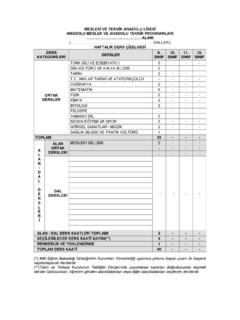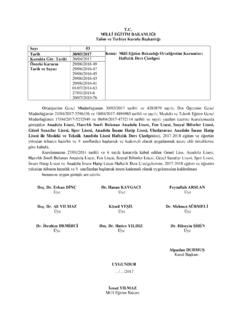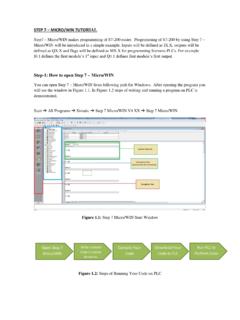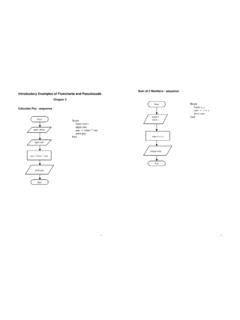Transcription of Theory of simple bending (assumptions) - Anadolu …
1 Theory of simple bending ( assumptions ) Material of beam is homogenous and isotropic => constant E in all direction Young s modulus is constant in compression and tension => to simplify analysis Transverse section which are plane before bending before bending remain plain after bending . => Eliminate effects of strains in other direction (next slide) Beam is initially straight and all longitudinal filaments bend in circular arcs => simplify calculations Radius of curvature is large compared with dimension of cross sections => simplify calculations Each layer of the beam is free to expand or contract => Otherwise they will generate additional internal stresses. Key Points: 1. Internal bending moment causes beam to deform. 2. For this case, top fibers in compression, bottom in tension. bending in beams Key Points: 1.
2 Neutral surface no change in length. 2. Neutral Axis Line of intersection of neutral surface with the transverse section. 3. All cross-sections remain plane and perpendicular to longitudinal axis. bending in beams Key Points: 1. bending moment causes beam to deform. 2. X = longitudinal axis 3. Y = axis of symmetry 4. Neutral surface does not undergo a change in length bending in beams P A B RB RA M M Radius of Curvature, R Deflected Shape Consider the simply supported beam below: M M What stresses are generated within, due to bending ? bending Stress in beams Neutral Surface M= bending Moment M M Beam x (Tension) x (Compression) x=0 (i) bending Moment, M (ii) Geometry of Cross-section x is NOT UNIFORM through the section depth x DEPENDS ON: Axial Stress Due to bending : stress generated due to bending : Neutral Surface bending Stress in beams bending Stress in beams Stresses due to bending N N R E F A C B D Strain in layer EF =yR E=Stress_in_the_layer_EFStrain_in_the_la yer_EFE= yR y=ER y=ER =ERyNeutral axis N A y dy dA force on the layer=stress on layer*area of layer = dA=ER y dATotal force on the beam section =ER y dA =ERy dA For equilibrium forces should be 0 y dA=0 Neutral axis coincides with the geometrical axis Stress diagram x x M M x Moment of resistance N A y dy dA force on the layer=stress on layer*area of layer = dA=ER y dAMoment of this force about NA =ER y dA y=ER y2 dATotal moment M= ER y2 dA=ER y2 dAStress diagram y2 dA =I M=ERI MI=ERx x M M x Flexure Formula MI=ER= yBeam subjected to 2 BM In this case beam is subjected to moments in two
3 Directions y and z. The total moment will be a resultant of these 2 moments. You can apply principle of superposition to calculate stresses. (topic covered in unit 1). Resultant moments and stresses Section Modulus Section modulus is defined as ratio of moment of inertia about the neutral axis to the distance of the outermost layer from the neutral axis Z=IymaxMI= yMI= maxymaxM= maxIymaxM= maxZSection Modulus of symmetrical sections Source:- 1 BEAMS: COMPOSITE BEAMS; STRESS CONCENTRATIONSS lide No. 1 Composite Beams bending of Composite Beams In the previous discussion, we have considered only those beams that are fabricated from a single material such as steel. However, in engineering design there is an increasing trend to use beams fabricated from two or more No. 2 Composite Beams bending of Composite Beams These are called composite beams.
4 They offer the opportunity of using each of the materials employed in their construction No. 3 Composite Beams Foam Core with Metal Cover Plates Consider a composite beam made of metal cover plates on the top and bottom with a plastic foam core as shown by the cross sectional area of Figure 26. The design concept of this composite beam is to use light-low strength foam to support the load-bearing metal plates located at the top and No. 4 Composite Beams Foam Core with Metal Cover PlateshftmtmbFoam CoreMetal FacePlatesFigure 26 Slide No. 5 Composite Beams Foam Core with Metal Cover Plates The strain is continuous across the interface between the foam and the cover plates. The stress in the foam is given by The stress in the foam is considered zero because its modulus of elasticity Efis small compared to the modulus of elasticity of the = ffE(53)4 Slide No.
5 6 Composite Beams Foam Core with Metal Cover Plates assumptions : Plane sections remain plane before and after loading. The strain is linearly distributed as shown in Figure No. 7 Composite Beams Foam Core with Metal Cover PlatesNeutral AxisCompressive StrainTensile StrainxyMFigure 275 Slide No. 8 Composite Beams Foam Core with Metal Cover Plates Using Hooke s law, the stress in the metal of the cover plates can be expressed asxmxmmmmIMyIMEEyE == == therefore,//but (53)(54)Slide No. 9 Composite Beams Foam Core with Metal Cover Plates The relation for the stress is the same as that established earlier; however, the foam does not contribute to the load carrying capacity of the beam because its modulus of elasticity is negligible. For this reason, the foam is not considered when determining the moment of inertia No.
6 10 Composite Beams Foam Core with Metal Cover Plates Under these assumptions , the moment of inertia about the neutral axis is given by Combining Eqs 54 and 55, the maximum stress in the metal is computed as ()2222222mfmmfmNAthbtthbtAdI+= = (55)()()2max2mfmmfthbtthM++= (56)Slide No. 11 Composite Beams Foam Core with Metal Cover Plates The maximum stress in the metal plates of the beam is given by()()2max2mfmmfthbtthM++= (56)hftmtmbFoam CoreMetal FacePlates7 Slide No. 12 Composite Beams Example 1A simply-supported, foam core, metal cover plate composite beam is subjected to a uniformly distributed load of magnitude q. Aluminum cover plates in. thick, 10 in. wide and 10 ft long are adhesively bonded to a polystyrene foam core. The foam is 10 in. wide, 6 in. high, and 10 ft long. If the yield strength of the aluminum cover plates is 32 ksi, determine No.
7 13 Composite Beams Example 1 (cont d)The maximum moment for a simply supported beam is given byWhen the composite beam yields, the stresses in the cover plates are()qqqLM180081210822max= ==psi 000,32max==yF 8 Slide No. 14 Composite Beams Example 1 (cont d)Substituting above values for Mmaxand maxinto Eq. 56, we getOr()()()()[] ,322+ +=++=qthbtthMmfmmf ftlb806inlb Beams bending of Members Made of Several Materials The derivation given for foam core with metal plating was based on the assumption that the modulus of elasticity Efof the foam is so negligible,that is, it does not contribute to the load-carrying capacity of the composite beam. 9 Slide No. 16 Composite Beams bending of Members Made of Several Materials When the moduli of elasticity of various materials that make up the beam structure are not negligible and they should be accounted for, then procedure for calculating the normal stresses and shearing stresses on the section will follow different approach, the transformed section of the No.
8 17 Composite Beams Transformed Section Consider a bar consisting of two portions of different materials bonded together as shown in Fig. 28. This composite bar will deform as described earlier. Thus the normal strain xstill varies linearly with the distance yfrom the neutral axis of the section (see Fig 28b), and the following formula holds: yx =(57)10 Slide No. 18 Composite Beams Transformed SectionM x xyy yx = yE11 = yE22 = 28 (a)(b)(c)12 Slide No. 19 Composite Beams Transformed Section Because we have different materials, we cannot simply assume that the neutral axis passes through the centroid of the composite section. In fact one of the goal of this discussion will be to determine the location of this No. 20 Composite Beams Transformed SectionWe can write:From Eq. 58, it follows that yEEyEExx222111 == ==(58a)(58b)dAyEdAdFdAyEdAdF 222111 == ==(59a)(59b)Slide No.
9 21 Composite Beams Transformed Section But, denoting by nthe ratio E2/E1of the two moduli of elasticity, dF2can expressed as Comparing Eqs. 59a and 60, it is noted that the same force dF2would be exerted on an element of area n dAof the first material. ()()ndAyEdAynEdF 112 = =(60)12 Slide No. 22 Composite Beams Transformed Section This mean that the resistance to bending of the bar would remain the same if both portions were made of the first material, providing that the widthof each element of the lower portion were multiplied by the factor n. The widening (if n>1) and narrowing (n<1) must be accomplished in a direction parallel to the neutral axis of the No. 23 Composite Beams Transformed bb12 EEn=Figure 2913 Slide No. 24 Composite Beams Transformed Section Since the transformed section represents the cross section of a member made of a homogeneous material with a modulus of elasticity E1,the previous method may be used to find the neutral axis of the section and the stresses at various points of the section.
10 Figure 30 shows the fictitious distribution of normal stresses on the No. 25 Composite Beams Transformed Section xyIMyx = 30. Distribution of Fictitious Normal Stress on Cross Section14 Slide No. 26 Composite Beams Stresses on Transformed Section1. To obtain the stress 1at a point located in the upper portion of the cross section of the original composite beam, the stress is simply computed from To obtain the stress 2at a point located in the upper portion of the cross section of the original composite beam, stress xcomputed from My/Iis multiplied by n. Slide No. 27 Composite Beams Example 2A steel bar and aluminum bar are bonded together to form the composite beam shown. The modulus of elasticity for aluminum is 70 GPa and for streel is 200 GPa. Knowing that the beam is bent about a horizontal axis by a moment M= 1500 N-m, determine the maximum stress in (a) the aluminum and (b) the No.




